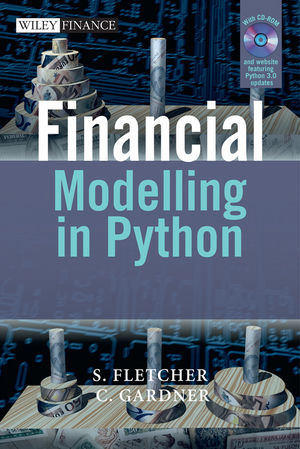Financial Modelling in PythonISBN: 978-0-470-98784-1
Hardcover
248 pages
August 2009
 This is a Print-on-Demand title. It will be printed specifically to fill your order. Please allow an additional 10-15 days delivery time. The book is not returnable.
|
||||||
1.1 Why Python?
1.2 Common misconceptions about Python.
1.3 Roadmap for this book.
2 The PPF Package.
2.1 PPF topology.
2.2 Unit testing.
2.3 Building and installing PPF.
3 Extending Python from C++.
3.1 Boost.Date Time types.
3.2 Boost.MultiArray and special functions.
3.3 NumPy arrays.
4 Basic Mathematical Tools.
4.1 Random number generation.
4.2 N(.)
4.3 Interpolation.
4.4 Root finding.
4.5 Linear algebra.
4.6 Generalised linear least squares.
4.7 Quadratic and cubic roots.
4.8 Integration.
5 Market: Curves and Surfaces.
5.1 Curves.
5.2 Surfaces.
5.3 Environment.
6 Data Model.
6.1 Observables.
6.2 Flows.
6.3 Adjuvants.
6.4 Legs.
6.5 Exercises.
6.6 Trades.
6.7 Trade utilities.
7 Timeline: Events and Controller.
7.1 Events.
7.2 Timeline.
7.3 Controller.
8 The Hull–White Model.
8.1 A component-based design.
8.2 The model and model factories.
8.3 Concluding remarks.
9 Pricing using Numerical Methods.
9.1 A lattice pricing framework.
9.2 A Monte-Carlo pricing framework.
9.3 Concluding remarks.
10 Pricing Financial Structures in Hull–White.
10.1 Pricing a Bermudan.
10.2 Pricing a TARN.
10.3 Concluding remarks.
11 Hybrid Python/C++ Pricing Systems.
11.1 nth imm of year revisited.
11.2 Exercising nth imm of year from C++.
12 Python Excel Integration.
12.1 Black–scholes COM server.
12.2 Numerical pricing with PPF in Excel.
Appendices.
A Python.
A.1 Python interpreter modes.
A.2 Basic Python.
A.3 Conclusion.
B Boost.Python.
B.1 Hello world.
B.2 Classes, constructors and methods.
B.3 Inheritance.
B.4 Python operators.
B.5 Functions.
B.6 Enums.
B.7 Embedding.
B.8 Conclusion.
C Hull–White Model Mathematics.
D Pickup Value Regression.
Bibliography.
Index.



